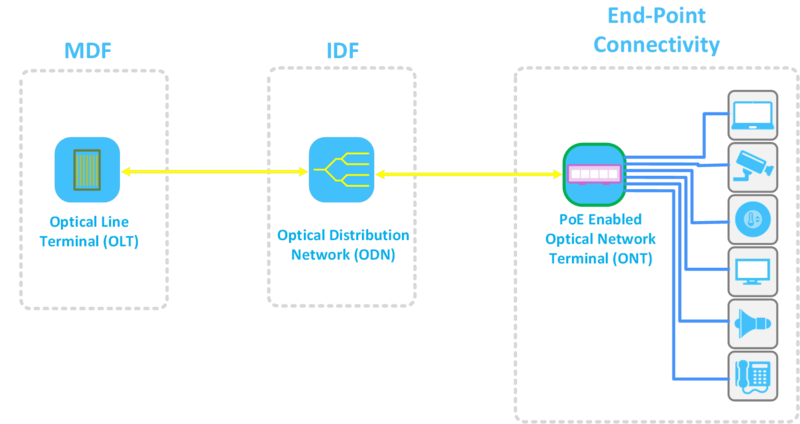Local Area Networks: Passive Optical vs. Traditional LANs
For decades, businesses have successfully deployed traditional local area networks (LANs) to transmit their critical data—and many continue to rely on these networks today. Built on a foundation of copper cables, such as Category 6A, LANs connect computers and devices so they can share information and resources across the network.
While passive optical local area networks (also called “passive optical LANs” or “POLANs”) have been an alternative option for LAN architecture, deployment requires extensive fiber knowledge. Until recently, most enterprises didn’t need fiber to support their speed and connectivity requirements, so POLANs were overlooked.
But times are changing. Corporations are investigating artificial intelligence, virtual reality, 5G and Wi-Fi 6. Smart buildings continue to automate and connect building systems to boost efficiency. College campuses offer hybrid and remote learning. Hotels are innovating to provide guest connectivity and personalization.
As a result, network backbones are more often being built on fiber to handle requirements for greater connectivity density, more bandwidth and faster network speeds. This opens the door to new opportunities involving passive optical LANs. POLAN is becoming a viable alternative to traditional LANs in applications where fiber is already needed. It relies primarily on fiber optic cabling, which, in some cases, can reduce network complexity and costs, eliminate distance restrictions, shrink material requirements and more.
Is POLAN the right fit for your next project? Let’s compare LANs and POLANs to see how they provide the same functionality in different ways.
Network Components
A traditional local area network (one with a 10 Gb/s backbone) relies on copper and is made up of multiple layers or levels of Ethernet cables, routers and active switches.
Meanwhile, a passive optical LAN consists of:
- Singlemode fiber for the backbone
- Passive optical splitters
- Optical line terminals (OLTs) that manage network intelligence
- Optical network terminals (ONTs) that manage devices from one management console in a flat network architecture
- Category cabling from Power over Ethernet-enabled ONTs to end devices
Functionality
A traditional LAN uses routers and switches to connect devices and manage the signal distribution between them.
A router at the network’s top layer connects to the campus or building switches. Distribution switches then connect to switches in telecommunications rooms (TRs). From there, copper cables run from TRs to devices.
A passive optical LAN, however, provides the same functionality in a different way. It’s a point-to-multipoint network that relies on FTTx architecture and protocols instead of switch-based Ethernet.
To establish a POLAN, a strand of singlemode fiber runs from the headend or OLT to the desired location. It connects to a passive optical splitter that multiplies and relays the signal to other fiber strands through optical distribution waveguide technology. Each strand can connect to an ONT that supports anywhere from one to hundreds of devices.

Architecture & Space Requirements
In fiber environments where space is a concern, a POLAN can help optimize real estate.
To support up to 2,000 users (the size of a large company, for example), a traditional copper backbone LAN needs 90 rack units of space (18 standard equipment racks). Depending on the application, this may take up valuable floor space that could be used for another purpose.
LANs also require end devices to be within 100 m of a telecommunications room to comply with TIA standards. These special-purpose rooms take up square footage as well.
Because it’s based on fiber, a passive optical local area network serves more users in less space. For example, to support up to 7,000+ users, only nine rack units (housed within a single standard equipment rack) are required.
A POLAN also requires fewer TRs (or, in some cases, eliminates them). This is because singlemode cabling can extend up to 30 km compared to the 100 m limit of copper cable.
By eliminating TRs or switches every 100 m, a passive optical LAN reduces the amount of space required for cabling. Passive splitters further decrease space requirements by reducing fiber count.
Energy Use
POLAN’s small footprint and simplified architecture may help reduce environmental impact.
For a few reasons, a POLAN can be considered an energy-efficient choice:
- A POLAN has fewer cooling requirements. The passive components used between the ONT and OLT emit less heat and operate within a greater temperature range. This lowers energy usage by eliminating the need for power and cooling in TRs.
- In a passive optical network, the components themselves also consume less power than active components, which contributes to lower energy use.
Lifecycle
If fiber is in your future, then a passive optical local area network can extend the network lifecycle to two decades or longer.
While copper cables can, in theory, support speeds of up to 10 Gb/s, depending on the cabling system used, no current technology is better than fiber when it comes to bandwidth. Its performance isn’t limited by the cable. Instead, performance is limited by the electronic components that make up the system. As these components improve, existing fiber cable is able to support them.
Fiber has lower latency as well, which means it can carry data across longer distances without delays or interruptions for fast downloads and uploads and quick access to resources.
When it’s time to support higher speeds, a passive optical LAN will be ready to support speeds of 100 Gb/s or faster.
Security
Fiber cables don’t emit or radiate signals or interference. Instead, the signals that travel through fiber cables are contained inside fiber strands. This makes it incredibly difficult to use taps to “listen” to a fiber cable.
By using a single management/IP address for every 8,000 Ethernet ports (instead of the approximately 350 switches required with a traditional LAN, each with their own IP address), a passive optical local area network reduces IP addresses and management interfaces. In turn, this diminishes targets for breaches.
Costs
Nearly everything we’ve mentioned so far—space requirements, energy usage, installation and material requirements, network lifecycle, etc.—presents an opportunity for cost savings.
The Association for Passive Optical LAN (APOLAN) Technology Committee published a cost comparison between passive optical LANs and Ethernet switches. This study verified savings of between 40% and 56%, validating the cost effectiveness of POLANs. There are fewer components to purchase, and fewer hours are required for installation.
A reduction in the number of network components also reduces ongoing operating costs. With centralized intelligence and management, labor hours dedicated to maintenance and management are reduced. Instead, teams can focus on more critical issues, such as everyday moves, adds and changes. This is especially important as IT and networking staff face ongoing skills gaps and labor shortages.
More to Come on POLAN
Special thanks to Tellabs for helping Belden with this blog. Both organizations see the benefits of POLAN in the right applications and are active members of APOLAN and HTNG (Hospitality Technology Next Generation).
Throughout the year, we’ll be working on a series of POLAN blogs together, covering topics like:
- POLAN’s contributions to sustainability
- Power options for POLAN, including Class 4
- Why POLANs can support smart buildings
- Overcoming common POLAN misconceptions
Subscribe to our blog so you don't miss out!
Related resources:
Guest Author
 John Hoover
John Hoover
Marketing Director, Tellabs; Board Director, APOLAN
John Hoover is a marketing director at Tellabs and board chair of the Association for Promoting Optical LAN (APOLAN). Over the past 20 years, he has influenced industry milestones such as early passive optical network deployments, video implementations, wireless and, more recently, the global adoption of passive optical LAN for enterprise. Connect with John on LinkedIn.
